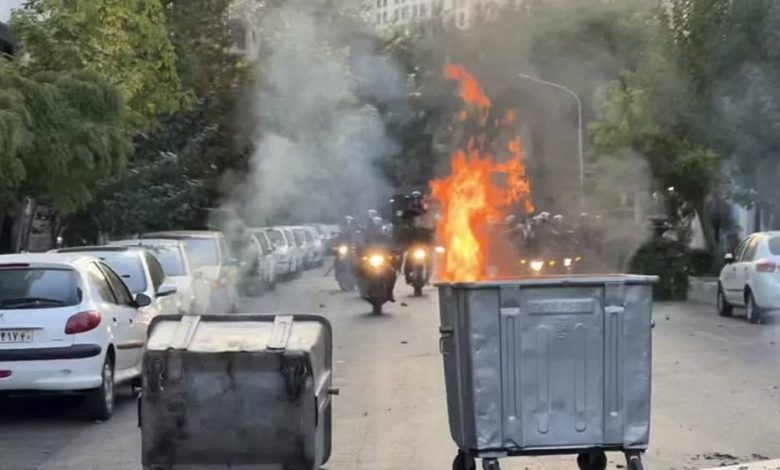What to Make of IRGC’s Recent Warnings Against MEK inside Iran

Written by
Aladdin Touran
The notorious Intelligence Organization of the Revolutionary Guards (IRGC) issued a “significant” statement addressing the “Iranian people” warning about any cooperation with the Iranian opposition, the Mujahedin-e Khalq (MEK) organization. Amid the widespread protests, this statement has raised several speculations.
“If suspicious communications are established with you, requesting actions such as carrying out sabotage actions, setting fire to places, signs, and symbols or writing graffiti, taking photos and filming specific military and religious places, or holding gatherings and demonstrations and so, (be aware that) the MEK has established these communications. Therefore, inform the nearest IRGC intelligence unit or the News Headquarters of the IRGC Intelligence Organization,” the statement reads.
#Iran mullahs' different apparatus of intelligence issue warnings against tuning in to #MEK guidance and directives during #IranRevolution2022 .
Do you go out and put your life in danger upon a simple telephone call?
No, unless the call's from someone you absolutely trust. pic.twitter.com/EXkCE72gFA— Aladdin Touran (@AladdinTouran) November 12, 2022
Since the beginning of the nationwide uprising, authorities have expressed their fear of the MEK and its impact on society.
“Yesterday, one of my friends told me something which left me in pain. He said he met one of these rioters on the streets and asked whether he hated the Islamic Republic more or the hypocrites. The guy responded to my friend, ‘first, their name is not the hypocrites. It’s called the Mujahedin-e Khalq (MEK). Secondly, what have they done wrong?” the state-run Ofogh TV network quoted Hossein Sazoor, and state-affiliated eulogist, on November 5.
Some other officials, like Esmail Khatib, the Minister of Intelligence and Security, acknowledged that protests are organized and led by well-organized groups.
“These recent riots had a complicated plot, unlike the past scattered protests. Small groups would instigate these protests with timely and bold actions. They were fully organized and guided. Interestingly, once the demonstration initiated, these units immediately left the scene to start another riot in another part,” Khatib said in an interview with the website of the regime’s supreme leader Ali Khamenei on November 9.
For many years, Iran’s ruling theocracy tried to paint the Iranian opposition as a “fringe grouplet” with “little to no popular support.” This demonization campaign went hand in hand with the brutal repression of the MEK supporters, such as the mass executions in the 1980s.
But soon after the first major Iran protests in 2018, Khamenei acknowledged MEK’s role in organizing anti-regime demonstrations. Since then, Khamenei and other top officials have warned each other of the MEK’s “danger.”
With the growing popularity of social media apps, the clerical regime’s one-sided propaganda ended. Seeing the rising trend of youth approaching the MEK and its Resistance Units network, Tehran increased its efforts on social media to tarnish the MEK’s image.
Iran 2022: MEK Resistance Units Take Major Strides in Iran
A recent report tallied by the Iranian Resistance unveiled how, since the beginning of the nationwide uprising, Tehran’s propaganda machine has focused on attacking the MEK, squandering the country’s resources to vilify its viable alternative both in reality and on social media.
“The Iranian regime has also officially acknowledged having deployed tens of thousands of fake social media accounts to disguise as dissident groups or individuals while trashing the organized resistance and trying to delegitimize those who truly advocate regime change,” reads the report in part.
Ruhollah Mo'men Nasab, parliamentary special advisor on the so-called "internet users projection bill" and former commander of the cyber army reveals how #Tehran has been using @Twitter for #propaganda.
#Iran #InternetFreedom pic.twitter.com/kHzjtlEFvR— NCRI-FAC (@iran_policy) March 29, 2022
If the MEK is indeed a “fringe grouplet” with no future, why would Tehran allocate such vast resources to tarnish its image? Besides, if the MEK lacks popular support, who would accept to carry out their demands over a phone call or by a message on social media, especially when doing so would have heavy consequences for them?
Tehran has a long history of failed efforts to fight the rising popularity of its viable alternative.
In 1981, the regime’s then-supreme leader, Ruhollah Khomeini, desperately asked people to “spy” on the MEK. Calling himself and his regime “Islam,” he said: “When Islam is in danger, you should preserve it even by lying. To preserve the holy state, you are even allowed to drink alcohol, and you must lie.”
Khomeini finally found the solution in massacring tens of thousands of MEK members and supporters, such as executing over 30,000 political prisoners in a few months in 1988. But what could Khamenei do now?
Issuing an anti-MEK statement wouldn’t save the day for the regime. After four decades of oppression, Iran’s volatile society yearns for change. Indeed, it approaches a movement that advocates that change and rejects any return to the past dictatorships or the current religious fascism. Bereft of any real solution, Khamenei and his regime cling to more brutality and futile attempts to tarnish the MEK’s image in a bid to confront an existential threat posed by the current revolution, spearheaded by the Iranian Resistance.

